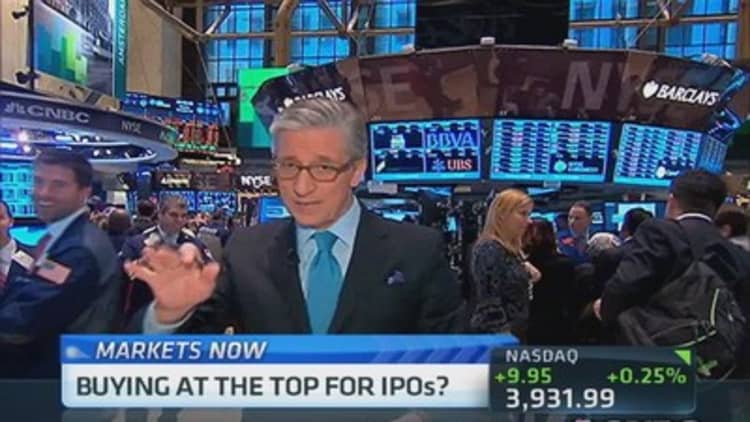Buying at the top for initial public offerings (IPOs)?
Amid all the excitement around the Twitter IPO and the strong IPO market this year, it's interesting to note that the Renaissance Capital IPO ETF (IPO), which started trading in mid-October at $20.05, is basically flat at $20.16 after a few weeks of trading.
The mutual fund that the company runs, the IPO Plus Aftermarket Fund (IPOSX), has had a terrific run, rising almost 50 percent this year, but has essentially stalled out since mid-September.
Twitter today ranged the IPO range from $17-$20 to $23-$25.
Elsewhere

1) Real estate brokerage company Realogy reported earnings and revenues above expectations. The company, which owns Coldwell Banker and Century 21, among several real estate firms, reported a 29 percent increase in transaction volume (number of home sales times price). That is well above the industry average.
What about higher rates hurting sales? CEO Richard Smith argued that the opposite happened--sales have actually accelerated. "In our view, the strong volume increase was driven by a combination of pent-up demand, relatively low inventory and a shift in home buyer preference to purchase existing homes over new homes, due to the ability to lock in mortgage rates for the shorter period it takes to close on an existing home purchase over a new home," he said.
Well, maybe. It may be true that there was a rush to buy in the early part of the quarter (July), but there are certainly indications that higher rates slowed sales elsewhere. CFO Anthony Hull did note that fourth quarter transaction volume was expected to grow, but at a slower pace.
Finally, the market is certainly convinced of slower sales: the stock, which went public a year ago and had a strong run in the first half of this year, is now at its low for the year. It closed out 2012 at $41.96, but closed Friday at $40.67, down fractionally for the year. Any upside in RLGY would of course depend on whether existing home sales accelerate.
2) Speaking of home builders: Tri Pointe Homes , which went public at the end of January, is buying the home building business of Weyerhauser for $2.7 billion. The cash-and-stock deal is expected to close by the second quarter of next year. However, here's the key point: Weyerhaeuser shareholders will control 80.5 percent of the company.
3) More on the home building industry: Vulcan Materials, which is big in crushed stone and cement, also reported a strong quarter as higher prices were reflected across most markets.
CEO Don James said, "Demand for our products continues to benefit from recovery in private construction activity, particularly residential construction, in many of our key markets. Growth in residential construction activity, and its traditional follow-on impact on private nonresidential construction, continues to underpin our expectations for future volume growth and earnings improvement."
They reported improving construction activity in Arizona, California, Georgia, and Texas. Aggregate shipments were up 16 percent in the first nine months in those states. Those five account for about one-third of all U.S. housing starts.
4) The European Central Bank will be meeting on Thursday, and given that euro zone inflation readings that were out last Thursday were very weak, there is a chance ECB head Mario Draghi may cut interest rates.
It is a bit strange that Draghi has not followed the Fed and the Bank of Japan in aggressively lowering rates. The strength in the euro is certainly hurting European exports, and there are many reports that prices are falling in Europe. They certainly have cover to lower rates.
The October nonfarm payroll reports are due on Friday with expectations for a gain of 120,000 jobs. That's a pretty low figure: There have been only three prints below that in the last two years.
The first read on third quarter gross domestic product (GDP) will be out on Thursday, with expectations of a gain of 1.9 percent. Again, this is pretty anemic given that last quarter was up 2.5 percent.
In fact, it's pretty anemic given the growth since the financial crisis. Between the fourth quarter of 2009 and the first quarter of 2012, five of those 10 quarters had GDP growth over 3 percent. Since then, only two of the five quarters have had growth over two percent.
Now that's a deceleration!
—By CNBC's Bob Pisani


